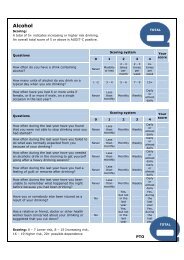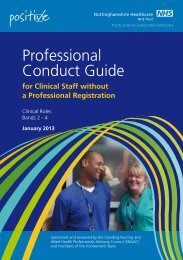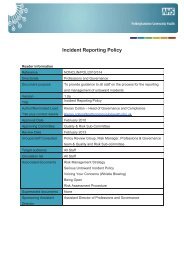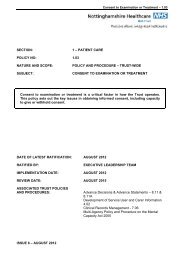Prevention and Control of Infections - Standard Precautions Policy
Prevention and Control of Infections - Standard Precautions Policy
Prevention and Control of Infections - Standard Precautions Policy
Create successful ePaper yourself
Turn your PDF publications into a flip-book with our unique Google optimized e-Paper software.
<strong>Prevention</strong> & <strong>Control</strong> <strong>of</strong> <strong>Infections</strong> - St<strong>and</strong>ard <strong>Precautions</strong> – 18.12<br />
9.6 Excreta should be either flushed down the toilet or disposed <strong>of</strong> into a macerator. Wipes<br />
<strong>and</strong>/or paper towels which are not flushable must not be used in this process. The affected<br />
area to then be cleaned using combined detergent <strong>and</strong> disinfectant.<br />
10.0 WASTE MANAGEMENT<br />
10.1 The Trust Waste Management <strong>Policy</strong> (16.08) <strong>and</strong> local management <strong>of</strong> waste procedures<br />
must be followed when h<strong>and</strong>ling <strong>and</strong> disposing <strong>of</strong> clinical <strong>and</strong> sharps waste.<br />
10.2 Clinical Waste<br />
10.2.1 Clinical waste is deemed as any human tissue <strong>and</strong> disposable items <strong>and</strong> materials<br />
that have been used on patients, e.g. dressings, wipes, gloves, masks, aprons <strong>and</strong><br />
paper tissues all <strong>of</strong> which to be disposed <strong>of</strong> into an orange clinical waste bag. Soiled<br />
mattresses should also be included within this definition although the local Waste<br />
Manager to be contacted when it is necessary to dispose <strong>of</strong> mattresses.<br />
10.2.2 Ensure that products that have been contaminated with blood or body fluids are<br />
disposed <strong>of</strong> as clinical waste.<br />
10.2.3 Infectious clinical waste including dressing b<strong>and</strong>ages <strong>and</strong> wipes should be disposed<br />
<strong>of</strong> in an orange bag 50 micron mesh.<br />
10.2.4 Waste which has the appearance <strong>of</strong> clinical waste e.g. gloves, masks or aprons<br />
should be treated as clinical waste, whether infected or not. This waste looks<br />
<strong>of</strong>fensive <strong>and</strong> would be difficult to prove that it was not contaminated. This also<br />
applies to continence waste such as pads, urinary catheters <strong>and</strong> drainage bags,<br />
whether from a urinary catheter or a stoma.<br />
10.3 Sharps Waste<br />
10.3.1 Refer to paragraph 7 above.<br />
10.3.2 Includes syringes, needles, cartridges, empty or partially used injection vials/<br />
ampoules <strong>and</strong> other sharp instruments.<br />
10.3.3 As a general rule sharps waste to be placed in yellow plastic sharps bins with yellow<br />
lids. If there is a large amount <strong>of</strong> sharps used for venepuncture, these are to be<br />
disposed <strong>of</strong> in an orange-lidded sharps bin.<br />
10.3.4 Purple-lidded bins to be used for the disposal <strong>of</strong> cytotoxic <strong>and</strong> cytostatic<br />
medications. For Rampton Hospital only, the procedures in “Guidance No: 22<br />
Management <strong>of</strong> Oral Cytotoxic Drugs On Wards” to ensure safe h<strong>and</strong>ling <strong>and</strong><br />
disposal <strong>of</strong> these medicines to be followed.<br />
11.0 LAUNDRY<br />
11.1 Safe h<strong>and</strong>ling <strong>of</strong> foul or infected linen minimises the risk <strong>of</strong> infection to staff required to<br />
h<strong>and</strong>le <strong>and</strong> launder the linen. HSG(95) 18 Hospital Laundry Arrangement for Used <strong>and</strong><br />
Infected Linen to be followed to minimise the risk <strong>of</strong> infection <strong>and</strong> injury to health care<br />
workers <strong>and</strong> the wider community.<br />
11.2 Definitions<br />
• Used linen – any linen from non-infected persons<br />
• Soiled linen- linen soiled with excrement or body fluids<br />
ISSUE 1 – FEBRUARY 2011 7










